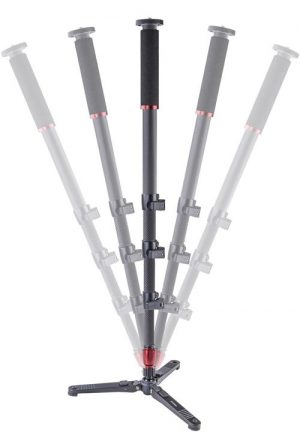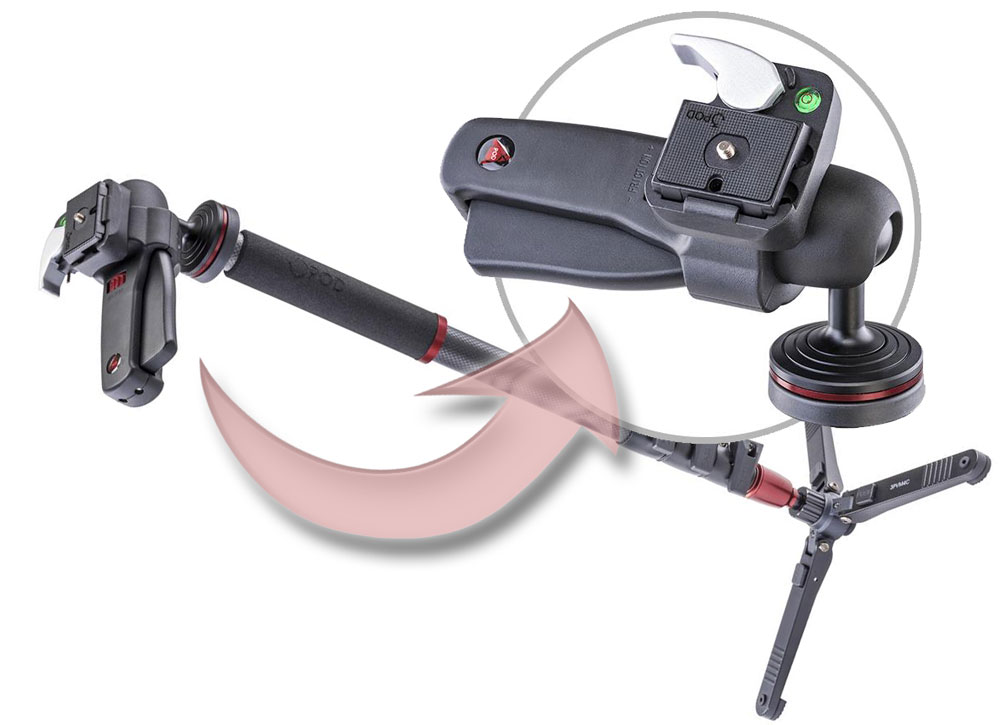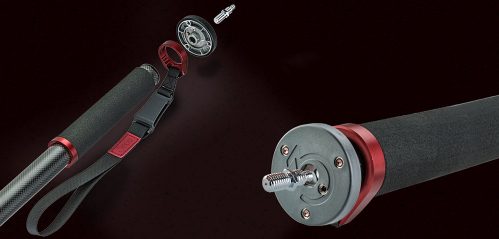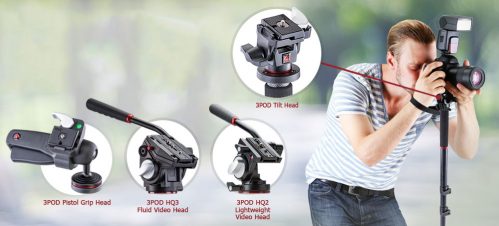 Manufacturer: 3Pod/Adorama
Manufacturer: 3Pod/Adorama
Website: Adorama.com
Description: Stabilize your shooting on the go without the bulk of a tripod
Purchase/Rent: Purchase
Pricing:
Orbit 4 Carbon Fiber Monopod: $99.95;
Q3 Fluid Tripod head : $99.95
(Kits with other heads: $120-$180)
Expected Release: Available Now
Review Issue: #124 (6/16)
Update Issue: #130 (12/16)
Reviewed By: Jeremy T. Hanke
Final Score: 10 (out of 10)
If you ask any filmmaker what things they hate about tripods, they’ll tell you essentially the same things: they’re too heavy, they’re extremely awkward to carry, they’re hard to set up, and they’re hard to get level. Still, at the end of the day, they’re the only way to create a locked down shot without using a cinesaddle (or putting your camera on a flat surface and praying that it doesn’t fall or get knocked off).
Now, the monopod, on the other hand, is easy to set up, but, up until now, has been relegated to still photographers, due to the fact that it’s essentially little more than a walking cane with a camera mount on the top, making it essentially useless without a person there to actively stabilize it.

The creative folks at 3Pod have been exploring some different ways to reinvent monopods that make them more like the way we wish tripods were, by “cheating” on the definitions and creating a really impressive product in the process!
We had a chance to really put the Carbon Fiber variant of the Orbit monopod through its paces, as well as the optional Q3 Fluid Tripod head designed for video use. Read on to find out what we discovered!
Ease of Use
When I first started pulling the Orbit Monopod out of the box, I found that it reminded me of a well-designed K-Tek carbon fiber boom pole, but when I got it completely out of the box, I realized it looked more like medieval mace than a boom pole. That’s because the tricky folks at 3Pod had affixed three fold-up “legs” to the bottom of the retracted monopod.
When popped out, the legs snap in place to form a pseudo-tripod of sorts that stabilizes the monopod, so you can leave it with your camera attached if you need to. When you want to pack it up again, large buttons on each leg are easy to find which allow the legs to fold up once pressed.
When extending out the monopod from its retracted state, 3 flip locks allow gravity to do most of the work of opening the monopod for you (and are a huge improvement from the triangular screw locks 3Pod used in the V2AH tripod we reviewed from them last year).
To further make setup a breeze, there’s a hex-key collar that can be popped off (but is designed to stay attached to the monopod) that holds the hex key you’ll need for any minute adjustments to the the flip locks’ tension.
To attach a tripod head to the monopod, it’s a super easy process to just take off the included rubber cover (which protects the ¼”-20 default mount) and then screw on the head. However, if you decide you don’t want to use a tripod head, the top of the monopod is actually a brilliantly-designed circular wrench that lets you easily unscrew the top, flip over the ¼”-20 head to discover a 3/8″ tripod screw. Quick as a whistle, it all goes back together again and you can mount the camera right to it. (Obviously, you lack a quick release plate that you would get when using a tripod head if you direct mount the camera to the monopod, but it’s still a pretty nice option that reduces the space the monopod takes up when stored, and can make the difference between bringing a stabilizer or not on some space cramped trips or flights.)
Depth of Options
The depth of options in this monopod are really surprising, because it seems so simple until you really start using it.
The big thing that this new line of 3Pod monopods are based around is the Orbit Pivot Base, which is a fluid base fitted between the tripod leg stand and the main part of the monopod. Because it’s fluid-filled and designed to rotate up to 360 degrees, as well as tilt up to 40 degrees in any direction, you can create some really interesting shots.
To use the full range of motion, you just unscrew a metal sleeve above the tripod legs, so that the fluid ballhead in the base is revealed, freeing it to tilt and rotate as you desire. While the panning was a bit stiffer than I liked, the tilting motion was silky smooth. When you want your more locked down shot once more, just rescrew the sleeve and you’re good.
As an added bonus, this monopod actually is so well proportioned that it actually works as a different type of stabilizer than the manufacturers intended. While it’s not ideal with my full DSLR rig, I found this monopod worked quite well as an adhoc steadycam when I mounted my GoPro to it. If you decide to use it for this purpose, circle the monopod collar with your thumb and middle finger loosely, allowing the tripod base (especially if they’re opened up) to act like a pendulum, counterbalancing the camera at top and, with a little practice, keeping your movement surprisingly smooth as you walk. (In fact, I found that I preferred this makeshift steadycam to the official Tiffen Steadicam designed for the GoPro, due to how organic 3Pod’s monopod was in comparison.)
Finally, not only can the new Orbit monopod stabilize your camera in multiple ways, but it can even save your life. In a genius bit of marketing, the instruction booklet for the monopod actually has a list of tactical directions for using the monopod to stave off attackers in a life or death situation. As a black belt in karate myself, I found their instructions to be very well thought out and insightful, even if they lacked illustrations. (The carrying strap for the monopod and the clip that’ll hold it on your belt, further make this monopod a handy weapon in a pinch.) If the monopod wasn’t already getting a perfect 10 from me, this level of detail would’ve tempted me to raise its score. (Although I do enjoy the great amplifier scene in This is Spinal Tap, I’m afraid I’m not willing to start raising the max score “from 10 to 11.”)
The only improvement I can think of for this amazing item for a future version would be if they can figure out how to make the Orbit Pivot Base detachable, so it could serving as a mini tabletop tripod in a pinch, as that would allow you to go much lower profile than you can currently do with the monopod. (It seems like the key things for that to occur would be to use a 3/8″ screw to connect the Pivot Base to the monopod, sheathe the stabilizer feet entirely in rubber, and allow the stabilizer legs to lock in a downward angle, so they could really “grip” a slick surface. Then, when it’s detached, it would already have a 3/8″ tripod mount screw, and most of the versatility of a fluid head due to the Orbit Pivot Base being below the camera.)
Performance
At just two pounds, the lightness of this carbon fiber monopod really made toting it around a breeze, even when I had the extra weight of a tripod head attached. The tripod feet on the base really are a game changer for a general all-around monopod, giving a decent amount of tripod-like stability to it, while still having the convenience and mobility of a monopod. (With that said, even though this is really stable for monopod, this isn’t designed or suitable for effects shots that need to be sturdily locked down.)
As this monopod is really designed to move most fluidly with the Orbit Pivot Base, after testing it out with a fluid video tripod head in the Q3, I probably wouldn’t suggest a video head for use with this monopod. Even though the Q3 is a great fluid tripod head for use on an actual tripod, I personally found my movement of the fluid video head was at odds with how the fluid Orbit Pivot Base wanted to move, forcing me to grip the shaft more tightly and creating more jerkiness than when I used a less mobile photography head. (Although we haven’t had a chance to review one yet, I’d anticipate that 3Pod’s pistol grip head would likely be the ideal choice for an easy set up head for this monopod.)

Because the pistol grip head is asymetrically weighted, remember to be careful after removing a camera so it doesn’t fall over.
Review Update – December 8, 2016: Pistol Grip Head.
We’ve since had the chance to test this out with the 3Pod Pistol Grip head. While this is a little more awkward to actually use than I was initially expecting, it was generally much easier than working with the other forms of adjustable heads. Just be aware that, because the pistol grip is essentially asymetrical the setup is more likely to overturn if you take the camera off the tripod than it is with a normal tripod head. You can prevent this issue by adjusting the Pistol grip into the vertical position whenever you take a camera off of it. Overall, our tests prove this is a solid addition to add to your monopod set and worth the additional cost. -JTH
If you do decide to add a tripod head, you’ll want to pick up a larger carrying case, as the included carrying case snuggly fits just the monopod. I had a chance to use the 28″ Slinger BigBag and found it to be a great fit even with the bulkier Q3 head.
Value
For $100 for the carbon fiber version, this is a great deal for what you get, especially since you don’t technically have to use a tripod head with it. If that’s a little more than you can swing right now, 3Pod also makes an Aluminum version, which is a little heavier, a little less scratch resistant, and a little less durable for right around $75. Those are great price points for a piece of equipment that gives you so many options you normally would require a full tripod for.
If you want to get a kit with an actual tripod head, you’ll add between $20-$100 to that. The $150 kit will include the Pistol Grip tripod head I mentioned before. The Slinger 28″ BigBag, which fits both the monopod and a tripod head as one total unit, will run you about $30.
One extra nice value for this monopod is that it’s covered by a 5 year warranty. (Though, to be clear, this warranty is voided if you have to use the monopod for self-defense/combat purposes. However, that’s probably a pretty fair tradeoff.)
Review Update – December 8, 2016: Warranty.
With our continuing testing, we’ve run into one of the tension levers becoming insecure so the bottom part of the monopod won’t stay reliably extended. We’re touching base with technical support now and will update this review as we know how promptly they resolve the issue.
Update – December 12, 2016
Adorama technical support updated us about the method for dealing with this being a warranty replacement and we’re waiting to hear how long that will be.
Update – March 17, 2016
Three months after the initial approval of the replacement, we received a replacement monopod. Representatives from Adorama say their turnaround is normally much faster for regular customers, but the fact that we were a press outlet delayed the replacement. This seems very strange, considering we’re trying to help our readers know what they can expect if they have a warranty replacement, but that’s what we were told.
Final Comments
It’s been quite awhile since a piece of equipment we’ve reviewed has gotten a perfect 10, but the 3Pod Orbit 4 Section Monopod really deserves it. Not only does it reimagine what a monopod could be, but its ease of use is matched only by its versatility. And the fact that the manual even tells you how to use it to defend your life makes it also one of the most holistic products we’ve ever reviewed.
For documentary filmmakers and run-and-gunners, this could very easily become the item you keep attached to your camera every time it’s out of the bag.
|
Breakdown
|
|
|
Ease of Use
|
10.0 |
|
Depth of Options
|
10.0 |
|
Performance
|
10.0 |
|
Value vs. Cost
|
10.0 |
|
Overall Score |
10.0 |






